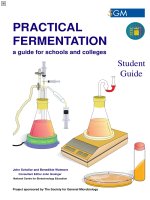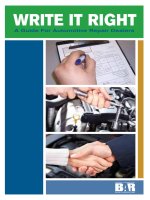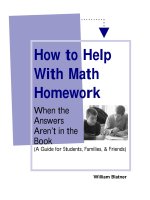Control Engineering - A guide for beginners - Chapter 6 doc
Bạn đang xem bản rút gọn của tài liệu. Xem và tải ngay bản đầy đủ của tài liệu tại đây (290.47 KB, 22 trang )
101
JUMO, FAS 525, Edition 02.04
6 Improved control quality through special controls
So far, we have only considered single-loop control circuits, where controller and process form a
closed signal loop. However, when using such single-loop control circuits, there are limits to the
control quality which can be achieved in certain control processes. It is possible to go beyond the
control quality limits imposed by the single-loop control circuit by using multi-loop control circuits,
or by switching auxiliary variables on and off. To some extent, relatively simple solutions can lead
to considerable improvements in control quality.
6.1 Base load
With a base load setting, the controller only influences part of the total manipulating variable, and a
fixed proportion is continuously supplied to the process (combination of control and operation). It
could then be the case that, for example in an electrically heated furnace, one section of the heat-
ing elements is controlled by the controller, whereas another section is supplied at full supply volt-
age (see Fig. 65).
Fig. 65: Base load setting
Essentially, base load setting offers the following advantages:
- The actuator, e.g. a thyristor controller, can be more compact and less expensive, as it only
needs to control low power.
- Load fluctuations on the supply network, as a result of power consumption in bursts caused by
the switching controller, are similarly reduced.
- If the controller fails, the process can still be operated with the base load component of the total
power.
Furnace
R1
K1
N
L1
x
t
100 % power
with base load
without base load
R2
6 Improved control quality through special controls
102
JUMO, FAS 525, Edition 02.04
Against the advantages shown, there are also a number of disadvantages:
- The dynamic control action is impaired, especially with regard to disturbances. As the controller
now no longer provides the full manipulating variable, the cooling curve, for instance, is not only
shifted by the amount of the base load setting, but is also clearly flatter (see Fig. 65). If, for any
reason, the power requirement suddenly becomes less than the base load setting, the controller
is helpless in this situation, as it cannot reduce the manipulating variable below the value of the
base load.
- In addition, the base load setting must also be matched to the setpoint. If the setpoint is
changed downwards, for instance, the excess power could suddenly be too large; with an
upward change, the excess power could be too small. In such cases, the base load should be
changed at the same time as the setpoint.
103
6 Improved control quality through special controls
JUMO, FAS 525, Edition 02.04
6.2 Power switching
If a process is being operated with different setpoints or working points, it is better to switch the
applied power rather than use a base load. In an electrically heated furnace, this can be achieved
by switching part of the heating elements through a limit value switch (limit comparator as an ad-
vance contact), in order to facilitate furnace operation at full power in the upper temperature range
(see Fig. 66).
This gives the following advantages:
- At any one time, the process can be operated in the upper third of the characteristic valid at that
time (see Fig. 66). In this way, the excess power at small values of the process variable can be
minimized.
- The dynamic control action is rather better here when compared with the base load method, as
in this case the control power can be reduced to zero (after falling below the changeover point).
There can be a disadvantage with this circuit if it operates with a setpoint close to the changeover
point, as the process has two different values of process gain here.
Fig. 66: Power switching
6 Improved control quality through special controls
104
JUMO, FAS 525, Edition 02.04
6.3 Switched disturbance correction
The effect of a disturbance can often be predicted within certain limits. For example, opening a fur-
nace door leads to a fall in temperature of 30°C. Instead of first waiting for the process to respond
to this disturbance and then for the controller to take corrective action, the disturbance can be re-
sponded to directly. To do this, the furnace door is fitted with a position switch that increases the
manipulating variable (e.g. heating power) by several percent when the furnace door opens.
This principle is known as switched disturbance correction. It is useful when the cause and effect
of a disturbance are known, and where the disturbance occurs frequently and reproducibly. The
disturbance is quickly compensated by the rapid response made possible without time delays
caused by the controller and process.
We will now look at three different possibilities of switched disturbance correction:
Maintaining the disturbance constant
The effect of the disturbance on the process variable is eliminated by maintaining the disturbance
constant by means of an auxiliary control loop (see Fig 67 a). Maintaining the disturbance constant
should only be used when suitable technology is available to measure disturbances and maintain
them constant.
An example of this is the temperature control of a gas-fired annealing furnace. Here, the main dis-
turbance, gas pressure, can be maintained constant by an in-line pressure controller, which at the
same time can also reduce the higher supply pressure to the lower burner pressure. The block dia-
gram of this method can be applied to our own example:
The controller has the job of bringing the process variable x of the process (the temperature of the
annealing furnace) to the setpoint w, by giving out the manipulating variable y. If the disturbance z
(the gas pressure) is not maintained constant, then, when the gas pressure fluctuates, the control-
ler has to change its output repeatedly, if it is to hold the same setpoint. The auxiliary controller (the
pressure controller) now maintains a constant gas pressure, so that this disturbance no longer in-
fluences the annealing furnace.
105
6 Improved control quality through special controls
JUMO, FAS 525, Edition 02.04
Fig. 67: Forms of switched disturbance correction
Additive/multiplicative switched disturbance correction
With both these methods, when the disturbance changes, the manipulating variable y of the con-
troller is manipulated to counteract the effect of the disturbance (see Fig. 67 b, c).
With additive switched disturbance correction (Fig. 67 b) the manipulating variable (y) is in-
creased by an amount proportional to the disturbance. In other words, this type of switched distur-
bance correction takes into account any offset shifts in the process. Controllers that allow such a
switched disturbance correction to be implemented (compact controllers), normally provide an in-
put for the switching signal. A signal proportional to the disturbance is applied to the controller in-
put, which influences the manipulating variable in accordance with the setting. To illustrate this, we
can take the example above where the furnace door is opened. When the door is opened, the ma-
nipulating variable is increased by a fixed amount.
a) Maintaining the disturbance constant
b) Additive switched disturbance correction
Controller
Process
Auxiliary
controller
y
w
x
z
Controller
Process
y
w
x
z
z
y
y
z
c) Multiplicative switched disturbance correction
Controller
Process
w
x
z
z
0—100%
K
P
6 Improved control quality through special controls
106
JUMO, FAS 525, Edition 02.04
A multiplicative switched disturbance correction exerts an influence on the controller gain K
P
. As
the measured disturbance changes its value, so the value of K
P
set at the controller is changed in
the same ratio, in the range 0 — 100% (see Fig. 67 c). This method is suitable for use in processes
where the manipulating signal (controller output) must be changed to the same extent as any dis-
turbance which may occur.
Fig. 68: Neutralization plant
As an example, a neutralization plant could be quoted, in which alkaline waste water is neutralized
with acid (see Fig. 68). The process variable is the pH value, which should be in the neutral range.
The controller exerts an influence on the pH value by changing the inflow of acid (y). First of all, let
us consider how the plant operates without multiplicative switched disturbance correction. As-
sume that the controller has stabilized at a defined flow rate with, say, 30% manipulating variable.
Now, the disturbance (flow) changes, and the quantity of waste water per unit time is now twice as
large. The pH value will now increase, and the controller will increase its manipulating variable until
the process variable reaches the setpoint again. This will be the case with 60% manipulating vari-
able (double the quantity of acid). We can see that the manipulating variable must be kept propor-
tional to the disturbance to maintain the same setpoint, other conditions remaining unchanged.
This can be achieved by measuring the disturbance (flow) and applying multiplicative switching.
The disturbance is scaled at the controller over the range from zero to the maximum disturbance
value which could occur; the controller now changes its proportional action to the same extent,
over the range 0 — 100%.
If we now look at our example again:
Assume here that the controller has stabilized again with, say, 30% manipulating variable. Now the
disturbance (flow) changes to twice the value. Likewise, through the multiplicative switched distur-
bance correction, the proportional gain (that corresponds to the overall gain, see also Fig. 41) is set
to double its value. The manipulating variable of the controller immediately increases to 60% and
there are no larger control deviations.
The examples of switched disturbance correction shown here apply to discontinuous controllers
with 2-state action and continuous controllers. The relationships for 3-state, modulating and actu-
ating controllers are more complex, and will not be discussed here.
107
6 Improved control quality through special controls
JUMO, FAS 525, Edition 02.04
6.4 Switched auxiliary process variable correction
Where a disturbance cannot be measured or localized, it is possible to derive an auxiliary process
variable X
aux
from the process, where X
aux
has a shorter time delay than the main process variable
x, and apply it to the controller input, after suitable conversion (see Fig. 69). In this way, the distur-
bances at the process input (e.g. supply disturbances) are quickly reported to the controller.
However, X
aux
is normally applied through an adaptive timing element, so that the process variable
is not distorted under stabilized conditions. With this arrangement, two control loops, each with its
own complete signal path, are coupled together. It should be noted that the control loop can possi-
bly become unstable as a result of overly strong switching of the auxiliary process variable and an
unsuitable controller setting.
Fig. 69: Switched auxiliary process variable correction
6.5 Coarse/fine control
Two control loops in series are used to maintain some parameter of a mass flow or energy flow
constant. The residual deviation from the first controller, the coarse controller (C1), is corrected by
the second, fine controller (C2) – see Fig. 70.
Fig. 70: Coarse/fine control
6 Improved control quality through special controls
108
JUMO, FAS 525, Edition 02.04
Here again we can use as an example a pH control system for neutralizing industrial waste water.
Because of the large variations in inflow normally present, and the changing composition, it is often
appropriate to connect two control loops in series, so that the variations in pH value are maintained
within the permissible tolerances.
6.6 Cascade control
Cascade control can significantly improve the control quality. This applies in particular to the dy-
namic action of the control loop, in other words, the transition of the process variable following set-
point changes or disturbances. Processes with a T
g
/T
u
ratio less than 2 or 3 can be difficult to
control with a simple control system; because of the relatively long delay time, the controller does
not become aware of how it should respond until a very late stage. We therefore try to split the con-
trol loop into several partial loops (usually two), which are controlled separately. Control of these
partial loops is much easier, as each has only a fraction of the overall delay time. This arrangement
is also known as multi-loop or networked control.
Fig. 71 shows the block diagram for cascade control.
Fig. 71: Cascade control
An auxiliary process variable x
aux
is derived from the process and applied to the input of an auxilia-
ry controller, the output of which controls the manipulating variable y. The setpoint w
1
of the auxil-
iary controller is determined by the manipulating variable of the main controller, such that the pro-
cess variable reaches the set value. The auxiliary control loop can be set to respond more rapidly,
and quickly eliminates all disturbances at the input to the process.
The subordinate auxiliary controller is constructed in the same way as an ordinary controller. How-
ever, it must have an input for an electrical setpoint signal, as its setpoint is set by the supervisory
controller. In other respects, it must be matched to the demands of its duty, with regard to input,
output etc. The auxiliary controller has the job of changing the auxiliary process variable very
quickly, in proportion to the manipulating variable of the main controller; hence P or PD controllers
are normally used for this application, or also, less frequently, a PI controller. The master controller,
set for setpoint response, is usually a PI or PID controller.
109
6 Improved control quality through special controls
JUMO, FAS 525, Edition 02.04
For cascade control, it is important that the subordinate loop is at least 2 — 3 times faster than the
outer loop, as otherwise the overall control loop will tend to oscillate. One advantage of cascade
control is that the dynamic response of the control loop is much improved. Another advantage is
that the controllers are much easier to adjust. The master controller is switched to manual mode,
and the slave controller is optimized. Then the master controller is optimized, with the slave con-
troller kept in automatic mode.
An example of cascade control is the temperature control of a furnace heated by a gas burner (see
Fig. 72).
Fig. 72: Cascade temperature control for a burner
The master controller outputs a manipulating variable y
1
in the range 0 — 100%, on the basis of
the control difference applied to it. The slave controller now receives this manipulating variable as
its setpoint, but only after the signal is normalized: on the basis of the normalization, the setpoint of
the slave controller (w
1
) amounts to 0 — “maximum gas flow”, corresponding to 0 — 100% manip-
ulating variable of the master controller. With its manipulating variable, the master controller practi-
cally presets the desired gas quantity per unit time. The slave controller has the job of controlling
the gas flow accurately. The slave controller now takes over part of the timing elements and cor-
rects disturbances at the input to the process, for example, fluctuations in the gas pressure. The
control action is improved on this basis, and, in certain cases, processes can only be controlled by
introducing cascade control.
6 Improved control quality through special controls
110
JUMO, FAS 525, Edition 02.04
6.7 Ratio control
Ratio controllers are used in burner controls (control of the gas/air mixture ratio), analytical tech-
niques (mixing of reagents) and in process engineering (preparation of mixtures). These controllers
have two process value inputs. The ratio of the two input variables is the real process variable. The
value required for this ratio is set as the setpoint, directly at the controller.
A ratio controller is frequently used as a slave controller. Here, the controller has the task of control-
ling the quantities of two substances in such a way that the mixing ratio stays constant when differ-
ing total quantities of the mixture are required. With this kind of slave control, there are two set-
points: the mixing ratio and the total quantity. Accordingly, two controllers are used, one of which
controls the total quantity of the mixture per unit time, whilst the other influences the mixing ratio,
by adjusting the dosage of the separate components. As the total quantity per unit time is the ulti-
mately decisive setpoint, this controller is designated as master controller, whilst the subordinate
controller controls the substance mixing ratio to meet the requirements of the master controller.
Fig. 73: Ratio control
An example of this is the mixture control shown in Fig. 73: two substances have to be mixed in a
fixed ratio to each other, whilst the demand for the quantity of the mixture fluctuates according to
production requirements. Two control circuits are required for this, one to control the total quantity
of both substances after mixing, the other to control the mixing ratio. In controlling the total quanti-
ty, it is sufficient to influence only one component, since the other is made to follow according to
the set ratio. However, the mixing ratio is controlled independently of the master controller, so that
the master controller and its associated valve have been fitted purely to control the air flow and
hence the total quantity. Without the master controller, only the mixing ratio remains constant,
whereas the total quantity of the two substances is disregarded.
A ratio controller is a standard controller whose input stage has two inputs to suit this modified
specification. With regard to the dynamic action, all the variations of the standard controller could
111
6 Improved control quality through special controls
JUMO, FAS 525, Edition 02.04
conceivably be used. Because of the nature of the process, the controllers are usually continuous,
modulating or actuating controllers, with PI or PID action. With microprocessor controllers, func-
tions such as ratio control can usually be configured directly.
6.8 Multi-component control
In a multi-component control system, various process-dependent variables produce the process
value for the controller and determine the control deviation, as in a steam/feed water control, for in-
stance (see Fig. 74).
Fig. 74: Multi-component control
In this case, the individual process values can each be allocated a different weighting factor, so
that they affect the control deviation to different extents; the main process variable is normally allo-
cated the highest weighting factor.
In the example given, the following relationship might apply:
x
3
= steam flow
x
2
= feedwater flow
x
1
= water level
If we now consider the relationship in the above formula without the constants, we have:
xx
1
2b x
2
2ax
3
c+()–()+=
xx
1
x
2
x
3
–()+=
6 Improved control quality through special controls
112
JUMO, FAS 525, Edition 02.04
We can see that when the steam draw-off x
3
is equal to the cold water supplied x
2
, the expression
in brackets becomes zero, and the process value x now depends only on the water level x
1
. Such a
multi-component controller must have suitable number of inputs, and, if necessary, a facility for
combining the individual signals via certain computations. In the example shown, there are three
components, hence this circuit has been given the name “3-component control”.
113
JUMO, FAS 525, Edition 02.04
7 Special controller functions
This chapter introduces a number of additional functions, i.e properties which are specific to par-
ticular controllers and are required for certain control tasks. With modern microprocessor-based in-
struments, such options can be implemented using suitable software.
7.1 Control station / manual mode
With a control or auto-manual station, the manipulating variable can be altered directly. The control
loop is interrupted so that the process variable has no significance. The controller now acts purely
as an operating device (see Fig. 75).
Fig. 75: Use of a control station
This feature is useful where valves or actuators have to be fully opened or closed for cleaning, as
this would not otherwise be possible. Control stations are also invaluable for trials and test runs,
when the manipulating variable has to be operated in manual mode, i.e. without automatic control.
They can be integrated in the controller or arranged as a separate instrument.
Nowadays, with many microprocessor controllers, the function of a control station is provided by
the manual mode setting. If a controller is switched from automatic mode (where the controller is
trying to control the process value at the setpoint) to manual mode, the control function is disabled.
Now the actuator, the thyristor power regulator, the cooling etc., can be controlled by setting the
manipulating variable manually. Manual operation is possible with all types of controller.
In manual mode, the operator could set a value for the actuator very different to the value of the
current manipulating variable set by the controller. However, such an extreme change could have a
destructive effect on the actuator. This problem is overcome by the provision of bumpless transfer
from automatic to manual mode, where the manipulating variable remains at its current value, and
can then be changed manually.
In case of a broken probe, caused, for example, by a cable fault or mechanical damage to the sen-
sor, automatic control is no longer possible, and the controller switches off the energy supply for
safety reasons. In certain processes this could destroy the batch or cause a lengthy loss of pro-
duction, owing to the long warm-up times or similar such conditions. Here, controllers offering
manual operation have the advantage that, in such cases, the process can still be operated manu-
ally, albeit with reduced accuracy, and brought to completion.
7 Special controller functions
114
JUMO, FAS 525, Edition 02.04
7.2 Ramp function
Ramp functions are often used in processes with delicate products or to protect heating elements,
as they ensure that the process variable approaches the setpoint slowly. In processes with large
excess power, it also makes sense to limit the rate of rise of the process variable. With this func-
tion, the user sets a maximum rate of change (e.g. in °C/min, °C/hr etc.) at which a ramp setpoint
travels towards the main setpoint. The process variable continuously tracks this changing value
(see Fig. 76).
Fig. 76: Diagram of the ramp function
When the ramp function is activated, the ramp setpoint is normally made equal to the current pro-
cess value, and then altered towards the main setpoint at the set gradient. Once the setpoint is
reached, the ramp function is terminated, and the instrument controls at the set value until, for in-
stance, the main setpoint is changed. If it does change, the newly activated value will once again
be approached by a ramp. In this way, both rising and falling ramps can be implemented.
7.3 Limiting the manipulating variable
A manipulating variable limit can be used to limit the controller output signal at either a maximum
or a minimum value. One application is where the actuating device fitted (e.g. pump, electric heat-
ing etc.) is over-sized; it avoids excess power and its associated problems, such as the process
variable overshooting the setpoint. Further, a minimum manipulating variable limit can be a wise
precaution in the control of gas burners, for instance. Setting a minimum manipulating variable
(e.g. 3%) avoids the gas supply being interrupted and thus the burner going out. The controller
then only gives out a manipulating variable within the range of the set minimum or maximum val-
ues.
In a continuous controller with a 0 — 10V output signal and a 5 — 95% range limitation, the output
signal is restricted to the range 0.5 — 9.5V.
115
7 Special controller functions
JUMO, FAS 525, Edition 02.04
7.4 Program controller
So far, we have always assumed that the process variable has to be maintained constant at a fixed
setpoint value. Such controls are also called fixed setpoint controls. In comparison, there are also a
number of manufacturing processes where the setpoint does not represent a fixed value for the
control system. Instead it represents a parameter which varies with time, i.e. a specific profile for
the variation of the setpoint with time is required. Controllers used for this application are called
program or profile controllers. They are often encountered as temperature controls, e.g. in anneal-
ing furnaces for metallic materials, in ceramic kilns, in chemical engineering for the batch manufac-
ture of products, in climatic chambers etc.
The selectable program time is normally of the order of minutes, hours or even days. Fig. 77 shows
such a profile for the course of the setpoint. Conditioned by the process, the course of the process
variable does not normally show the same sharp transitions as the setpoint profile.
Fig. 77: Diagram of a setpoint profile
The setpoint profiles are usually predetermined by an external programming device or a computer;
they are fed into the controller via the interface or a separate setpoint input. As the process variable
has to follow the continuously varying setpoint, the arrangement is also called follower control.
The rise of the setpoint profile must not exceed the rise of the process characteristic, otherwise the
process variable no longer follows the program profile, but rises at the maximum rate set by the
process characteristic (see Fig. 77). This is particularly important in non-linear processes such as
temperature controls, where the process gain decreases with higher process values. This can
sometimes be avoided by programming the instrument so that the program run is terminated as
soon as a certain deviation occurs, i.e. the process variable can no longer follow the program.
w/x
Rise too steep
Setpoint
Process value
200 °C
150 °C
100 °C
50 °C
2 h 4 h 6 h 8 h 10 h
t
7 Special controller functions
116
JUMO, FAS 525, Edition 02.04
7.5 Self-optimization
Optimum adjustment of a controller to the process can be a time-consuming affair, particularly if
the process concerned is rather slow. Furthermore, as we saw in Chapter 2.8, the optimal values
for X
P
, T
d
and T
n
are dependent on the working point. So it is quite likely that several sets of con-
trol parameters will have to be found for one process.
It seems an obvious step to let the controller itself make automatic adjustments to the control pa-
rameters. With microprocessor controllers, the facility for automatic controller setting (self-optimi-
zation) is available.
Basically, the choice lies between controllers which determine the control parameters simply on
the basis of user requirements, and adaptive controllers, where the settings are continually
checked and changed.
The methods used for self-optimization are usually built into the controller as software functional
blocks, and identify the process on the basis of the response of the process variable to step
changes in manipulating variable, and from this determine the best control parameters. The values
determined for X
P
, T
d
, T
n
etc. can be refined by the user (see Fig. 78).
Fig. 78: Operating principle of self-optimization
In principle, a self-optimization can be arranged, for instance, to take place about the setpoint: if
the controller has stabilized the process variable at the setpoint, the self-optimization can then be
started, and the controller outputs 100% and 0% manipulating variable alternately. The controller
determines the best parameters by examining the oscillations of the process variable about the
setpoint, and then automatically accepts the parameters. With this method, it should be ensured
that no damage can be caused when the process variable exceeds the setpoint.
117
7 Special controller functions
JUMO, FAS 525, Edition 02.04
Fig. 79 shows another type of self-optimization: in this case, the self-optimization process is start-
ed when the process value is below the setpoint. The controller determines the delay time from the
initial response of the process variable. The controller calculates a switching level based jointly on
the delay time and the gradient of the response of the process variable, and if this level is exceed-
ed it sets the manipulating variable to 0%. With a linear process, interposing the switching level
prevents the process variable from overshooting the setpoint. With non-linear processes, the over-
shoot is not completely prevented, but is at least reduced. In all, the controller outputs 100% ma-
nipulating variable twice, interrupted by a 0% manipulating variable output. Afterwards, the con-
troller accepts the optimized parameters and controls accurately at the setpoint.
Fig. 79: Fluctuation of the process variable about the switching line
Manufacturers normally assume a process with self-limitation and without dead time elements as
the basis for determining the control parameters. The closer the actual process corresponds to this
model, the more effective is the self-optimization.
7 Special controller functions
118
JUMO, FAS 525, Edition 02.04
7.6 Parameter/structure switching
By switching between parameter sets, it is possible to operate the controller in a control process
which requires different settings as the conditions vary. A set may comprise various parameters,
such as dynamic response, X
P
bands, cycle time C
y
etc. Some controllers even allow switching be-
tween complete controller structures, such as switching from PD to PID structure.
Switching between sets is initiated either via the controller’s logic inputs or via programmed values
which depend on the control deviation or various setpoint ranges (see Fig. 80).
Fig. 80: Schematic diagram of parameter set switching
Parameter set switching of this type finds application, for instance, when there are repeated start-
ups during automatic operation, where the setpoint must be reached in minimum time, and where
the process variable x must not overshoot the setpoint. This is not normally possible, however, with
the parameters used for stable operation. As an example, depending on the control deviation, the
controller switches from P action with a somewhat smaller X
P
band to PI action before the setpoint
is reached. Another application where switching can help is when running different charges in an
industrial furnace (annealing furnace). The control action of the process changes according to the
loading (half charge, full charge), and the controller must adapt to each individual case. Various pa-
rameter sets can be allocated, based on certain preliminary tests. Moreover, this special function
can be used to advantage where different working points are operated over the full range of the
characteristic, and where a non-linear process is concerned, in which variable margins of excess
power are to be expected.
7.7 Fuzzy logic
Fuzzy logic was developed in the USA by Lotfi A. Zadeh in 1965. This mathematical method is
based on the fuzzy set theory, which represents an extension of Boolean algebra. This technology
has undergone continuous development, and its advantages were quickly recognized in Japan,
where they began to apply the technology to a multitude of control tasks (fuzzy control). This appli-
cation of fuzzy logic to automation and control engineering represents a logical extension of tradi-
tional control technology.
119
7 Special controller functions
JUMO, FAS 525, Edition 02.04
A detailed coverage of this technology is outside the scope of this book; only its application in
combination with a PID controller will be illustrated. It should be mentioned briefly that fuzzy logic
deals with the subjective uncertainty of expressions, such as “temperature too high”, “pressure too
low” or “humidity too low”, as well as decision-making based on such linguistic variables. In this
way, it reconstructs the imprecise concepts of human thought.
The following illustrates how fuzzy logic and a PID control algorithm work together to improve the
disturbance and setpoint responses of a control loop. Fig. 81 shows the simplified block diagram
of a PID controller combined with a fuzzy module. The input variables of the fuzzy controller are the
control deviation and the time derivative of the process variable, as well as information on whether
the controller should operate for setpoint or disturbance response. The output manipulating vari-
able of the fuzzy controller is weighted by a parameter Fc1 and added to the manipulating variable
of the PID controller. In this way, the manipulating variable acting on the process is made up of the
manipulating variable of the PID controller and that of the fuzzy controller. A second output from
the fuzzy controller is a control output which influences the PID control parameters according to
parameter Fc2. Thus, with just two parameters, Fc1 and Fc2, the fuzzy controller can be matched
to the process.
Fig. 81: Simplified block diagram of a PID controller with fuzzy module
The fuzzy controller incorporates linguistic control blocks based on “IF-THEN” rules. These linguis-
tic rules determine the transient response of the fuzzy controller to setpoint changes and distur-
bances.
The combination of a fuzzy controller in parallel with a conventional controller offers several advan-
tages:
- With a non-linear process behavior or on higher-order processes, the fuzzy controller can com-
pensate for specific inaccuracies of the PID controller by supportive intervention under critical
operating conditions.
This is exemplified by systems whose behavior changes over the operating time. The fuzzy control-
ler is less sensitive to process parameter changes than the controller with its fixed parameter set-
tings. This means that variable process characteristics are dealt with more effectively by the com-
bination of fuzzy logic and the PID controller.
7 Special controller functions
120
JUMO, FAS 525, Edition 02.04
- For setpoint response, the integral fuzzy controllers increase the damping factor of the control
loop in certain conditions. This means that any tendencies to oscillate during the run-up to the
setpoint are reduced and overshoots are damped considerably.
- The problem of optimizing the controller specifically for setpoint or disturbance response is
lessened by the fuzzy components, as fuzzy control combines the control theory of both optimi-
zation criteria.
- When disturbances occur, the fuzzy controller responds more dynamically than the PID control-
ler and hence stabilizes the disturbance more rapidly. The criterion of control effectiveness is
improved, i.e. the resulting control error area is smaller than with stabilization by the PID control-
ler alone (see Fig. 82).
Fig. 82: Disturbance response of a third-order process, using a controller with and without
fuzzy module
We can summarize by saying that fuzzy logic, in its application as fuzzy control in automation and
control engineering, is highly regarded today, despite initial problems in accepting this technology.
The fuzzy concept has proved to be a powerful tool, particularly in complex control tasks. Tradi-
tional control technology will certainly not be replaced by fuzzy logic, but technological processes
will emerge that can be controlled more economically and more safely using fuzzy logic. The com-
bination of the fuzzy controller with the PID controller is a sensible example of this.
From this we can record that the fuzzy controller in general, as well as the combination of a tradi-
tional conventional controller and fuzzy module, bring about increased flexibility, so that the con-
troller can be better matched to different processes and control objectives.
121
JUMO, FAS 525, Edition 02.04
8 Standards, symbols, literature references
Standards
Standards and guidelines are very important in engineering, including control engineering. They lay
down concepts and designations, component values, dimensions, as well as important numerical
values and numerical ranges.
From the large number of published standards and guidelines, the following list below has been
limited to those which are useful for the basic principles of control engineering and have been used
in the preparation of this book.
Symbols
DIN 19 221 1993-05 Messen, Steuern, Regeln; Formelzeichen der
Regelungs- und Steuerungstechnik
(Measurement, operation, control; symbols in control engineering)
DIN 19 225 1981-12 Messen, Steuern, Regeln; Bennenung und Einteilung von Reglern
(Measurement, operation, control; control engineering concepts)
DIN 19 226 (1-5) Regelungs- und Steuerungstechnik;
Begriffe und allgemeine Grundlagen
(Control Engineering; Definitions and Terms)
DIN 19 236 1977-01 Messen, Steuern, Regeln; Optimierung, Begriffe
(Measurement, operation, control; optimization, definitions)
Guideline VDI/VDE 2189
Sheet 1
Beschreibung und Untersuchung von
Zwei- und Mehrpunktreglern ohne Rückführung
(Description and analysis of two-state and multi-state
controllers without feedback)
Guideline VDI/VDE 2189
Sheet 2
Beschreibung und Untersuchung von
Zwei- und Dreipunktreglern mit Rückführung
(Description and analysis of two-state and three-state
controllers with feedback)
Guideline VDI/VDE 2189
Sheet 3
Beschreibung und Untersuchung von Dreipunkt-Schrittreglern
(Description and analysis of modulating controllers)
Guideline VDI/VDE 2189
Sheet 4
Beschreibung und Untersuchung digital arbeitender
Kompaktregler
(Description and analysis of digital compact controllers)
Guideline VDI/VDE 2190
Sheet 1
Beschreibung und Untersuchung stetiger Regel-
geräte Grundlagen
(Description and analysis of continuous control
instrument fundamentals)
C
y
cycle time,
quasi-continuous controller
T
on
switch-on time,
quasi-continuous controller
edeviation T
osc
oscillation time,
discontinuous controller
f
sw
switching frequency,
discontinuous controller
T
s
stabilization time,
quasi-continuous controller
K
I
integral coefficient of the controller T
t
dead time
8 Standards, symbols, literature references
122
JUMO, FAS 525, Edition 02.04
References
- E. SAMAL / W. BECKER ‘Grundriss der Praktischen Regelungstechnik 18’
Basics of practical control engineering 18 (Oldenburg)
- LENZ /OBERST / KOEGST ‘Grundlagen der Steuerungs- und Regelungstechnik’
Fundamentals of control engineering (Hüthig Verlag)
- P. BUSCH ‘Elementare Regelungstechnik’
Elementary control engineering (Vogel Verlag)
- BÖTTLE / BOY / GROTHUSMANN ‘Elektrische Mess- und Regeltechnik’
Electrical measurement and control engineering (Vogel Verlag)
- D. WEBER ‘Regelungstechnik- Wirkunsweise und Einsatz elektronischer Regler’
Control engineering - operation and application of electronic controllers (Expert Verlag)
- D. WEBER ‘Elektronische Regler- Grundlagen, Bauformen und Einstellkriterien’
Electronic controllers - fundamentals, types and adjustment criteria (JUMO)
- JUMO GmbH & Co. KG ‘Betriebsanleitung- Universeller Programmregler
JUMO DICON 401/501’
Operating Instructions - universal profile controller JUMO DICON 401/501
K
IS
transfer coefficient of process
without self-limitation
T
I
integral time
K
S
transfer coefficient (process gain)
of the process
T
y
stroke time
K
P
proportionality factor of the controller V
max
maximum rate of rise
R ON-time ratio,
quasi-continuous controller
wsetpoint (SP)
R(%) ON-time ratio,
quasi-continuous controller in%
x process variable, process value (PV)
t time (continuous) X
Max
maximum process value (process variable)
T time constant of first-order process X
o
overshoot
T
a
approach time X
P
proportional band of the controller
T
C
oscillation time at X
Pc
X
Pc
critical X
P
, at which the control loop
with P controller oscillates uniformly
T
d
derivative time of the controller X
Sd
switching differential,
discontinuous controller
T
g
response time X
Sh
contact spacing
T
Mmin
minimum pulse duration,
modulating and actuating controllers
y manipulating variable (MV)
T
n
reset time of the controller y
H
manipulation range
T
off
switch-off time,
quasi-continuous controller
z disturbance
T
u
delay time









